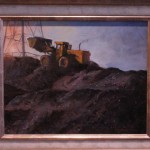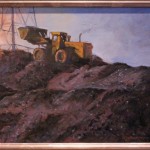In the pleasant confines of Wash Park Art, 1215 Elm Street, just a few doors down from Music Hall, the work of three painters and two photographers shared space handily in Urbanscape: Through Paint and Lens, a show that only recently closed. The gallery is the first floor of a 19th century row house and occupies both a long front room and the square room just beyond.
The three painters are Marlene Steele, Robert Hebenstreit, and Alice Allison; Tony Jones and Kim Starbuck are the photographers. Jones’ works were shown on the longest wall space in the front room and are both black and white and in color. The color works are eye-catching, the black and whites fantastic, so modulated by the use of today’s Piezography monochromatic inks and software for printing that they take on variations in tone as though there’s no end. Jones puts his camera close to its subject, at an angle. Patterns emerge. The Fuji color prints tend to suggest motion, in contrast to the serenity of the black and whites. These are all nuanced photographs, carrying out their maker’s intent of catching the moment in early morning or at sunset when, Jones says, “light brushes against the brick.”
The works seen in Urbanscape are not about people although many are about what the presence of people does to a landscape. Marlene Steele abandons recording the human figure here to document in oil on canvas work in progress, or “the industrial environment.” Things are happening, structures are taking shape, change is underway. The church that rises on Calhoun Street just west of Vine is serene above earth-moving activity on the hillside just below, in two paintings. Her colors shimmer in our gaze, none are flat, there’s a feeling that her brush moves rapidly but surely across her canvas. She finds inadvertent art in surprising places and things: a wire fence somewhat damaged is a pleasure to look at in her world.
Robert Hebenstreit focuses here on much the same subject matter as Steele in works that are tidier than hers, more tightly ordered, and sometimes include people. He’s interested in the utility vehicles that do the world’s work (a yellow bulldozer) and the useful man-made additions to our landscape (6th Street Viaduct, a train trestle). He also records places and things we all know: an entrance to Eden Park, figures enlivening the fountain of Fountain Square. I found Steele’s neatly imaginative response to what’s all around us more invigorating and interesting than Hebenstreit’s careful records, but it’s good to have both takes. Each artist was represented here by new works.
Kim Starbuck takes a panoramic look at what’s in the landscape; her camera bends space in a manner our eyes cannot and she also layers photographs to interesting ends. She seems to be at home in both color and black and white. The works in this exhibition reflect Barcelona and Madrid. One I particularly liked was a vertical composition in which a tree spreading its branches in generous display is silhouetted against a tall, smooth, modern building, its dimensions rigorously conceived. Both tree and building are beautiful, each in its own manner.
The inclusion of Alice Allison’s paintings in this show was noted as “a special exhibition, selected works” from the long-established artist’s Cincinnati views. Allison’s rosy palette produces easy to enjoy scenes we are likely to know ourselves: the “View from the Playhouse,” Mount Adams, Findlay Market. She likes roof-scapes, picked out by modest towers on perhaps 19th century houses. Two paintings are of pigeons, caged but looking convivial with each other. Texture is clearly an element Allison gives thought to; the pigeons as feathered creatures are fondly presented.
Although the end date for Urbanscape: Through Paint and Lens came just before Aeqai’s summer issue appeared, another exhibition was to be installed promptly. On view through August 23rd at this interesting gallery space overlooking Washington Park is Andrew Vansickle’s Pop Landmarks & Portraits as well as an exhibition by another Hebenstreit, Carin: Luminous Encore. Open times are a little quirky: 6 to 8 p.m. Thursdays and Fridays, Saturdays 4 to 8 p.m., Sundays 2 to 4 p.m. but hours will be extended during LumenoCity as works by each artist respond to that event. Hebenstreit includes a special LumenoCity commemoration and Vansickle presents his own tribute with his psychedelic vision of Music Hall in LumenoCity light projections. More information at www.washparkart.com.











